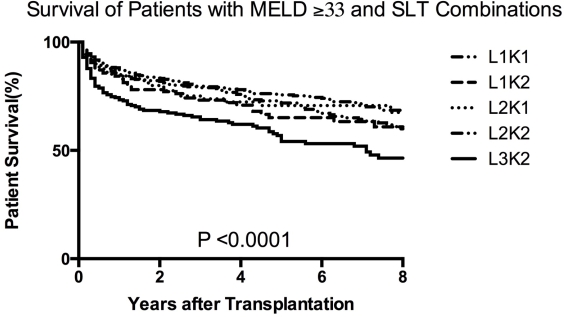The Effect of DRI and KDPI on Outcomes of High MELD Patients Undergoing Simultaneous Liver Kidney Transplant.
E. Chan,1 M. Hertl,1 J. Perkins.2
1General Surgery, Rush University Medical Center, Chicago, IL
2Surgery, University of Washington, Seattle, WA.
Meeting: 2016 American Transplant Congress
Abstract number: 77
Keywords: Donors, Kidney/liver transplantation, Outcome, unrelated
Session Information
Session Name: Concurrent Session: The Kidney in Liver Transplantation
Session Type: Concurrent Session
Date: Sunday, June 12, 2016
Session Time: 2:30pm-4:00pm
 Presentation Time: 2:42pm-2:54pm
Presentation Time: 2:42pm-2:54pm
Location: Room 302
Background: Patients with a high Model for End Stage Liver Disease (MELD) score have an increased risk for dying without transplant. Renal function worsens secondary to complications such as infection, or hepatorenal syndrome necessitating simultaneous liver and kidney transplant (SLKT) in a subset of these patients. These patients derive the highest survival benefit from transplant; however, they have been shown to have a worse outcome. Indices such as the donor risk index (DRI) in liver transplantation and the kidney donor profile index (KDPI) in kidney transplantation have been developed to predict graft failure and subsequently, outcomes following transplant. We sought to determine if these indices influenced the outcomes of these patients undergoing SLKT.
Methods: Our dataset included the UNOS/STAR database from 3/1/2002 to 3/31/2015 in patients with a MELD score of 33-40 who received a liver transplant alone (LTA) or SLKT. DRI of the hepatic allograft was calculated and the KDPI was taken from the STAR files. Livers were classified as low DRI (D1<1.3), moderate DRI (D2 = 1.3-1.7) or high DRI (>1.7). Kidneys were grouped into low KDPI (K1 ≤30%) or high KDPI (K2>30%). The survival outcomes based on SLKT with each pairing of DRI with KDPI (D1KI, D2K1, D3K1, D1K2, D2K2, D3K2) were reviewed.
Results: There were 67,143 LTA, 4950 SLKT and 1760 patients receiving SLKT with MELD ≥ 33. There was no difference in survival in patients who received a LTA or a SLKT with a low DRI and any KDPI (D1K1 or D1K2). Also, there was no difference in survival in patients who received a LTA or SLKT with a moderate DRI and any KDPI (D2K1, D2K2). However, survival was statistically worse in SLKT with high DRI (p= 0.005).
Conclusions: In patients with a MELD score >33 receiving SLKT, there is no difference in survival with a low DRI or moderate DRI liver with any KDPI kidney. Survival is markedly decreased with a high DRI liver and high KDPI combination. Consideration should be given to transplanting high MELD patients with a low or moderate DRI with any KDPI combination as their risk of dying on the waitlist is high. 
CITATION INFORMATION: Chan E, Hertl M, Perkins J. The Effect of DRI and KDPI on Outcomes of High MELD Patients Undergoing Simultaneous Liver Kidney Transplant. Am J Transplant. 2016;16 (suppl 3).
To cite this abstract in AMA style:
Chan E, Hertl M, Perkins J. The Effect of DRI and KDPI on Outcomes of High MELD Patients Undergoing Simultaneous Liver Kidney Transplant. [abstract]. Am J Transplant. 2016; 16 (suppl 3). https://atcmeetingabstracts.com/abstract/the-effect-of-dri-and-kdpi-on-outcomes-of-high-meld-patients-undergoing-simultaneous-liver-kidney-transplant/. Accessed December 21, 2025.« Back to 2016 American Transplant Congress
